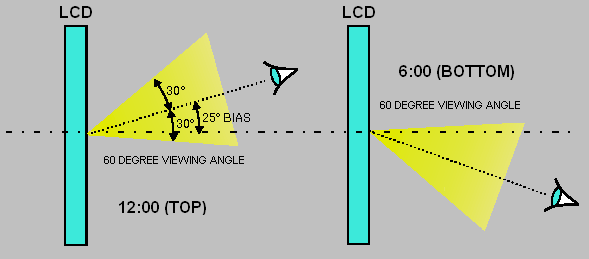
LCD Viewing Angles
![]() General
General
Liquid Crystal Displays have a limited viewing angle. They lose
contrast and become hard to read at some viewing angles and they have more
contrast and are easier to read at others. The size of the viewing angle is
determined by several factors, primarily the type of Liquid Crystal Display fluid and the duty
cycle. Because the viewing angle tends to be smaller than most people would
like, a bias is designed into the module at the time it is manufactured.
This means the nominal viewing angle is offset from the perpendicular by
some amount. Several versions of the LCD module are then offered with this
bias set to different angles or positions to accommodate as many
applications as possible. The term "bias angle" is often used erroneously
with the term "viewing angle".
![]() Definition
of Bias Angle and Viewing Angle
Definition
of Bias Angle and Viewing Angle
The bias angle is the angle from the perpendicular
from which the LCD Glass is best viewed. (See figure below) This angle is
determined when the display is designed, and can be set at any angle or
orientation. The orientation of the bias angle of an LCD display is often
stated with reference to a clock face. If the offset is above the display,
it is referred to as a "12:00" or "top" view. Pacific Display Devices offers
standard LCD displays with either a 12:00 or 6:00 viewing position, and can
produce a custom display with any viewing position.

The viewing angle is the angle formed on either side of the bias angle,
where the contrast of the display is still considered acceptable. An
STN character display running at a duty cycle of 1/16 has a viewing angle of
±20 degrees, and a bias angle of 25 degrees. For this example, assume the
display is a 12:00 (top viewing) type. When the display is viewed from 25
degrees above the vertical, it will have its maximum contrast and best
“look”. If the viewer moves his eye further above t he display by an
additional 30 degrees, he will see the display reduce in contrast (but still
be easily readable). Moving the viewing position any further above the
display will reduce its contrast to an unacceptable degree.
Additional viewing angles of 3:00 (right side) and 9:00 (left side) are also
offered as a special order.
![]() Contrast
adjustment and its Effect on Viewing Angle
Contrast
adjustment and its Effect on Viewing Angle
Adjusting the contrast voltage, VO, will effect the bias
angle to some extent, but not the viewing angle. 12:00 display can be
optimized for a 6:00 viewing position by adjusting the contrast voltage. A
12:00 display set for 6:00 viewing position will not have as great a
contrast as a 6:00 display set for 6:00 viewing position, and vice versa.
Designers often want a display to be optimized for straight-on viewing.
Either a 12:00 or a 6:00 module can be used; and the contrast voltage can be
adjusted slightly to optimize the display for that viewing position. In the
example used above, the viewing angles of both the 6:00 and 12:00 modules
actually overlap the perpendicular (or straight on) viewing position.